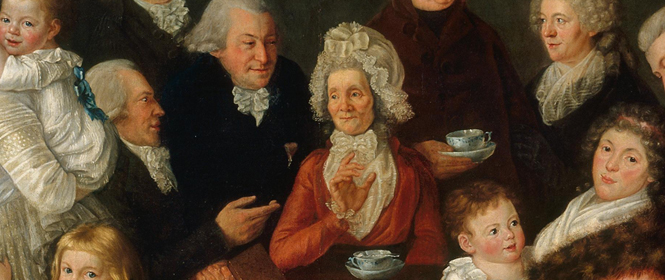
The invention of the grandmother
Every child knows what a grandma looks like: she has white hair, pinned up in a bun. We recognize this image of the grandmother even today. But they really don’t look like that any more. In fact, in jeans and trainers, grandmothers look quite a lot like mothers these days. For Mother’s Day, our blog inquires into the origins of the enduring cliché of the white-haired grandmother.
The elderly: from contempt to reverence
For a very long time, there was nothing particularly significant about grandparents. In medieval and early-modern times, families were primarily held together by the bond between parents and children. Frequently, youngest siblings would still be living in their parents’ house while the oldest had families of their own. Contrary to popular assumption, before the modern period, it was rare to have more than two generations under the same roof. For a long time, relatively late parenthood and low life expectancy meant only about ten percent of people lived to be grandparents. But this did not mean that the few elderly people alive were necessarily lavished with particular respect. On the contrary, old people unable to run a household were seen as unproductive, useless and even dangerous. One striking image in writings and pictures of that period depicts old women as wart-faced witches, who envy the young their attractiveness and liveliness. We particularly associate this image with fairy tales, but contempt for the old was an all-too-real social fact.
The 18th century invention of grandma
Things changed radically in the 18th century. The grandmother became a tender, idealised figure, the incarnation of eternal motherly love. As one grandson wrote, around 1800: “I was my grandmother’s favourite and had to sleep in her room. There she would often read me the evening prayer out of Starck’s Prayerbook […] She mollycoddled me with pure tenderness. It is because of her I was happy at home […]”.
Thanks to earlier childbearing and longer lifespans, grandmothers now more often lived long enough to know their grandchildren; as this happened, the esteem granted to their role also increased. The key factor in this was the emergence of the bourgeois separation of work and private spheres: in the bourgeois family imagination, grandmothers were women who lived only for the family, even more so than mothers, who had to contribute to the household economy.
The grandmother as heart and soul of the family
Our permanent exhibition contains an early representation of the grandmother as the core of the family: Friedrich Tischbein’s portrait of two Huguenot families – the Reclams. In the late 18th century, Tischbein was a popular portraitist: if you could afford to have him paint you, you had “made it”. Without question, the two Reclam families depicted here had done just that – one hundred years after the first Reclam, a Huguenot refugee, arrived in the Holy Roman Empire, the family clearly belonged to the bourgeois elite. The two best-known family members shown here are Pierre Frédéric Reclam, a preacher, and his brother, the court jeweller Jean Francois Reclam. At the heart of the painting is their mother, Marie Reclam, the grandmother. As shown here, she is the very core of the family. It is an extraordinarily clear representation of grandmothers’ transformed role.
The new reverence associated with grandmothers simultaneously bound these women within a tight social corset. Grandmothers were not supposed to be economically independent, sexually active or publicly visible. If an old woman transgressed this ideal image, she risked being judged by family and society, as in Bertolt Brecht’s short story, “The Unseemly Old Lady” (Die unwürdige Greisin).
But grandmothers in rural areas, like all women, were still heavily involved in work, just as much so as men. It was impossible to run a farm without a woman; this was true of most trades, and above all for those without property, in both town and country. A single wage was simply not enough to feed a family. Grandmothers had to work for their living as long as they could – they had little time to tell fairy tales.
21st century: the role of the grandfather becomes more important
According to surveys, grandmothers and grandchildren are closer today than ever before. Spatial separation and economic independence allow for peaceful relations, entered into by choice. Moreover, grandfathers are taking over more and more elements of the grandmother role, in the form first invented in the 18th century.